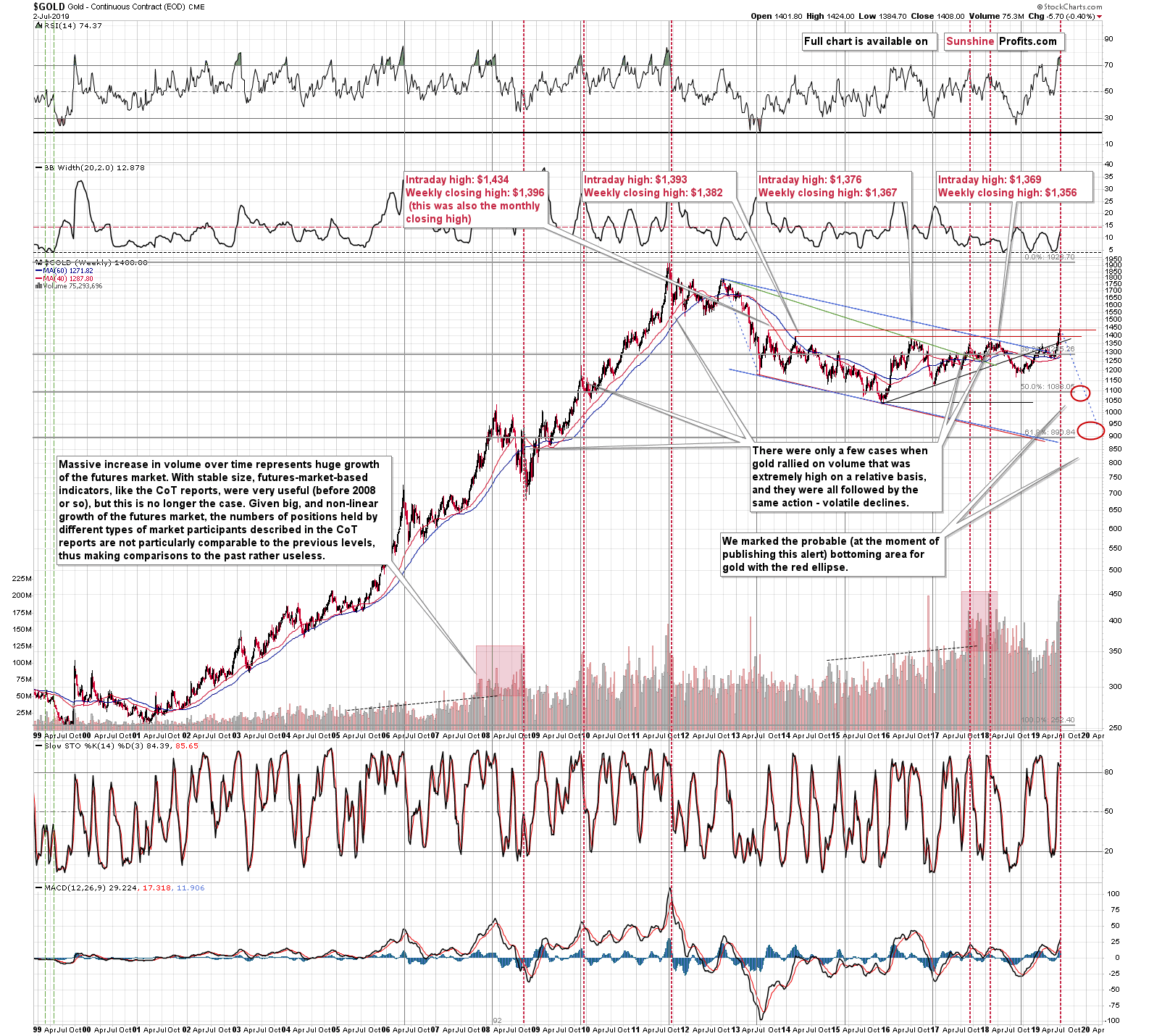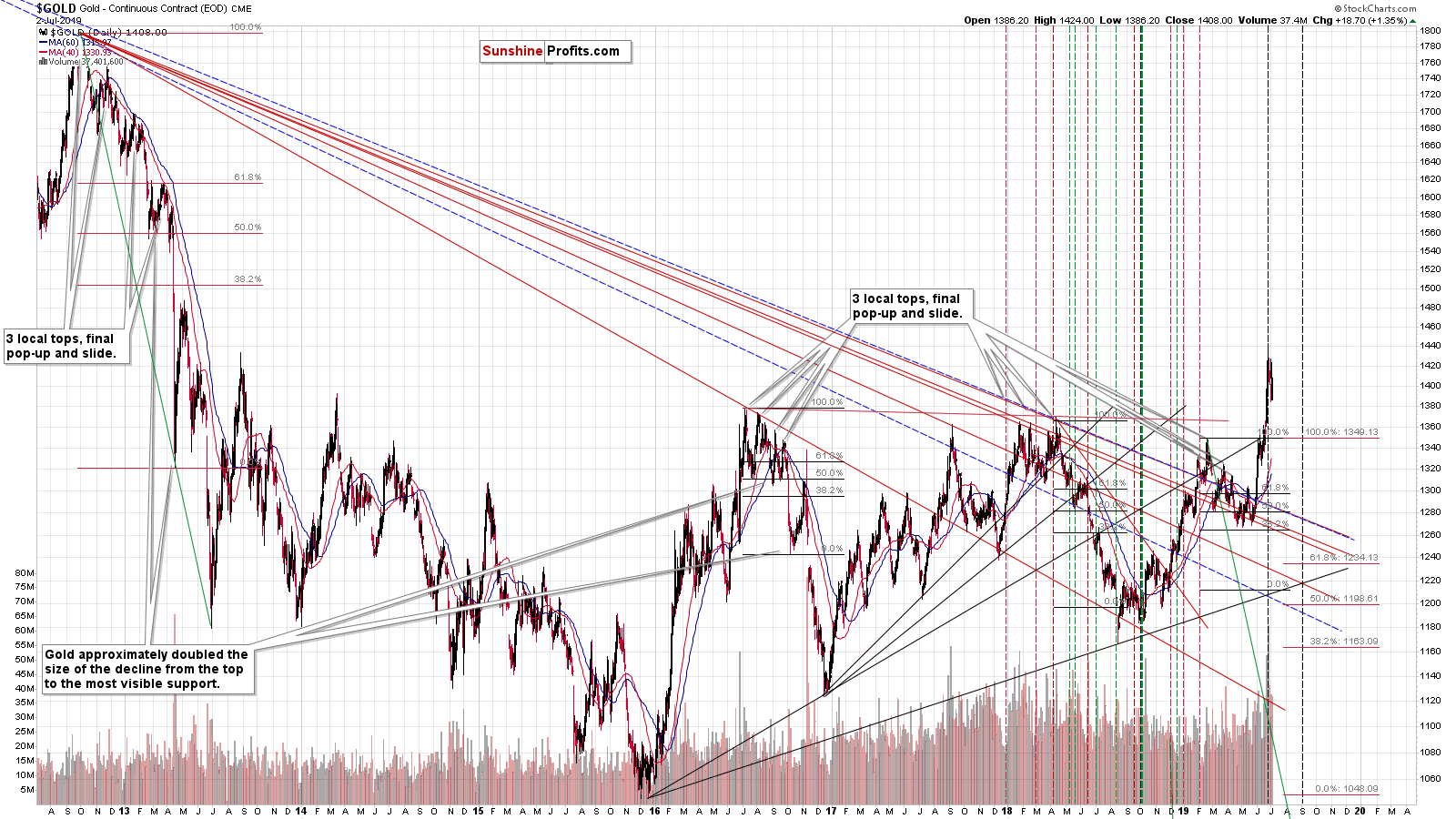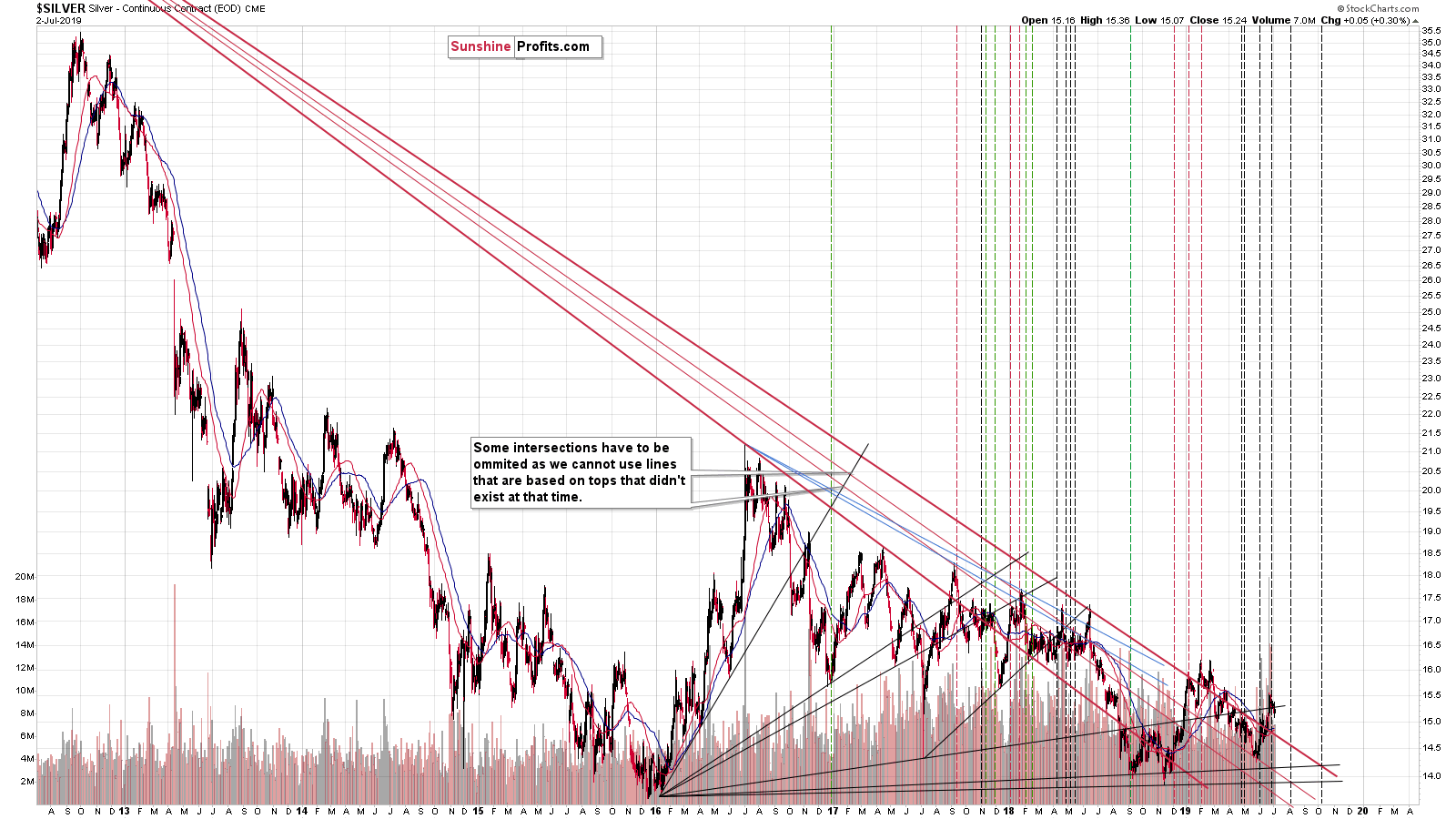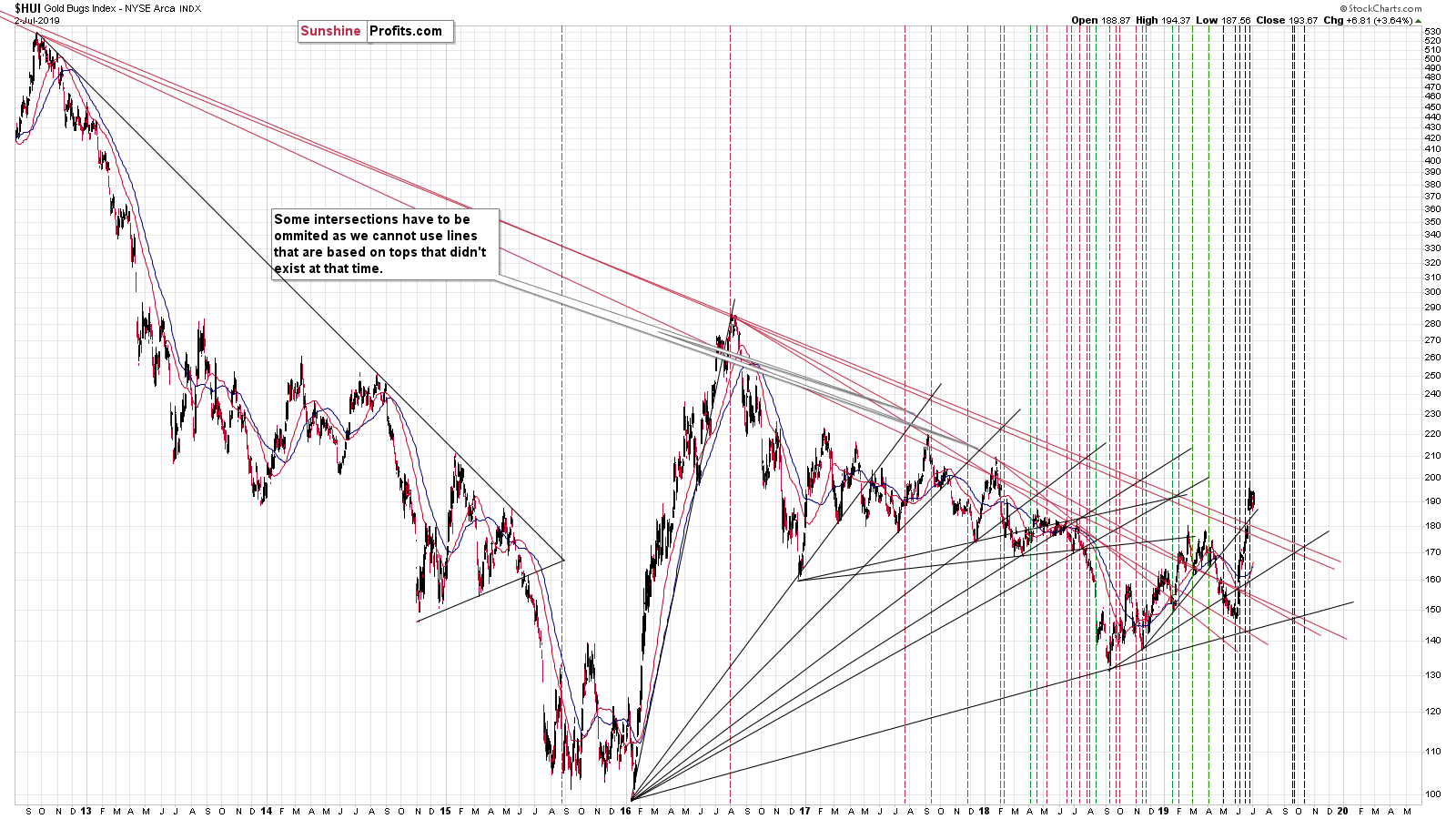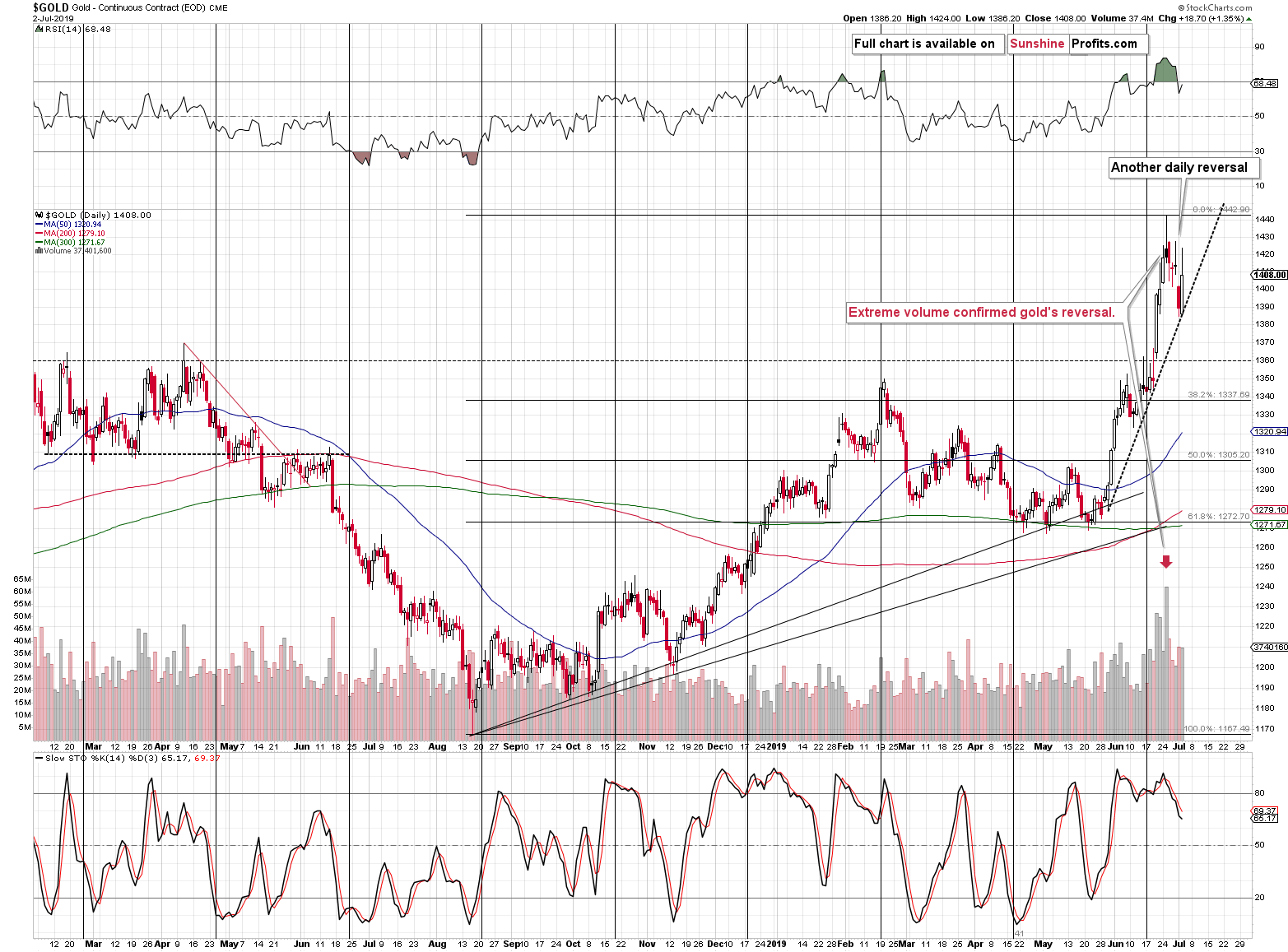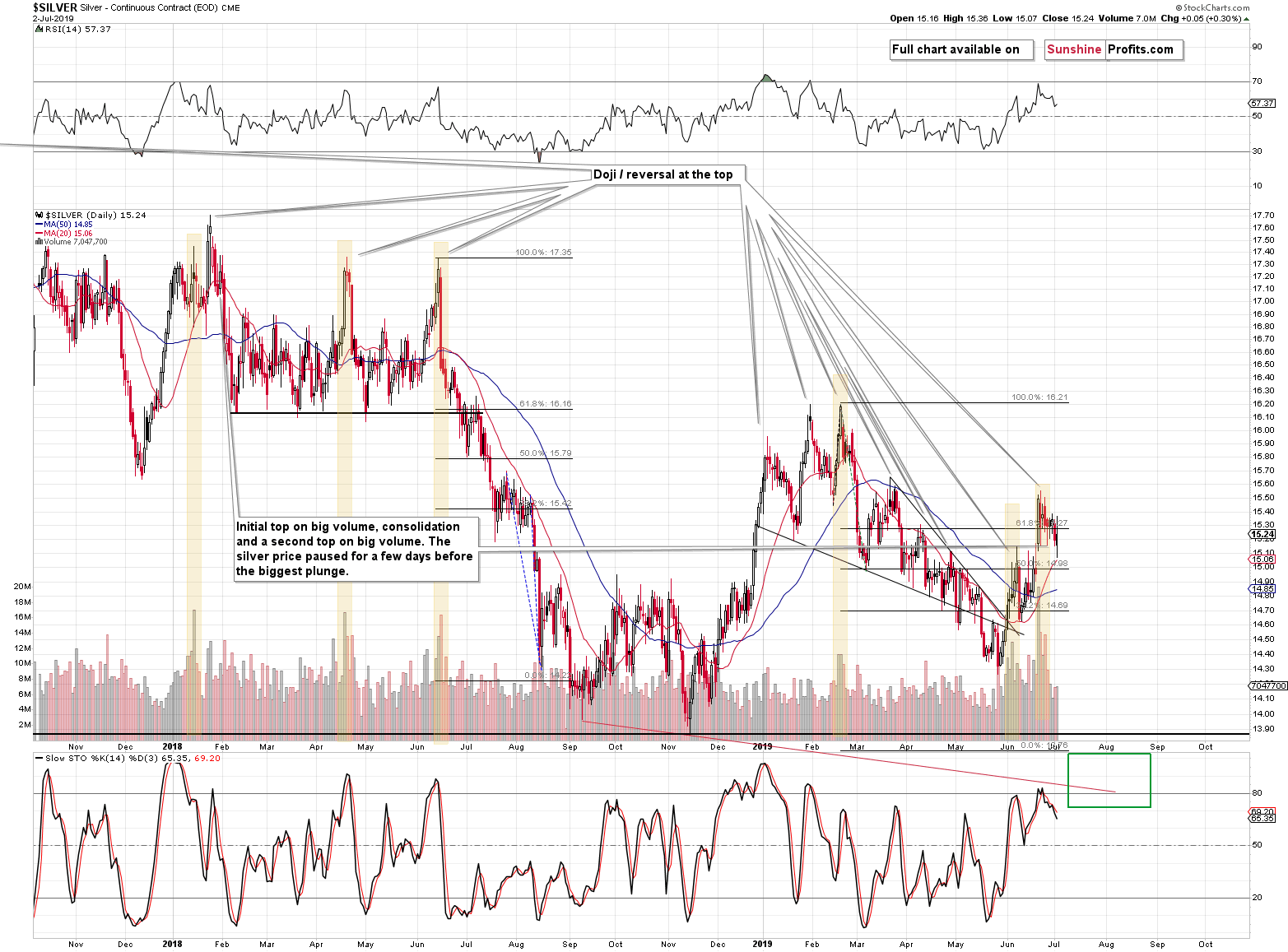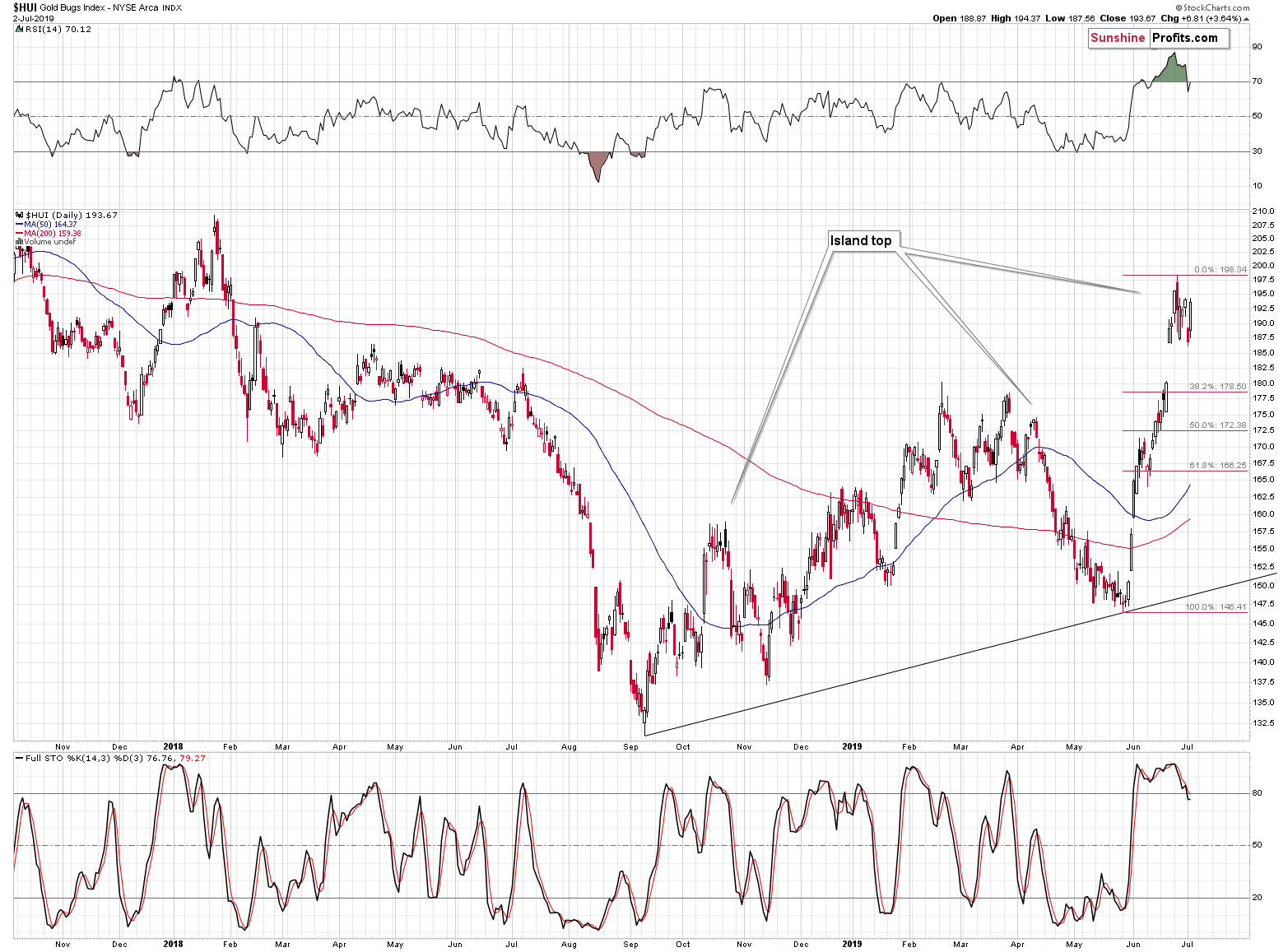Briefly: in our opinion, full (250% of the regular size of the position) speculative short position in gold, silver, and mining stocks are justified from the risk/reward perspective at the moment of publishing this Alert.
The precious metals market started the week with a big decline, but it was immediately followed by a relatively big rally. At the moment of writing these words, gold is even higher than it closed on Friday! Was the big decline just a local pullback on gold's way above $1,500?
In short, that's very unlikely, and while the size of the move is substantial, we shouldn't put more weight to it than to the signals that are of very long-term nature. For instance, gold's huge weekly volume.
Yesterday's Gold Upswing in Perspective
All cases when we saw huge weekly volume spikes marked excellent shorting opportunities, not instances where one could have invested in gold and profited on it in the following weeks (of course, there are some day traders, who might have done that, but that's an exception, not the rule).
Did yesterday's upswing change any of that? Absolutely not. Has gold declined already in a really profound manner, just like it did after all the other huge-volume occurences? No, it didn't slide yet. This means that the plunge is most likely just around the corner. Of course, we can view it as it being already underway, and we can treat yesterday's and today's pre-market upswing as counter-trend moves. Regardless of the name that we use, gold is likely to decline profoundly in the following weeks.
Let's take a look how yesterday's price moves related to the long-term triangle-vertex-based reversals.
Did That Impact the Below Reversals?
We can comment on all three charts at the same time, because they were impacted in the same way. That is - they weren't. The move higher in silver was barely visible, while the move in gold didn't change anything. Gold appears to have reversed right at the late-June reversal.
There's one more thing that we would like to add about the HUI Index - proxy for gold stocks. Or actually two things.
The first thing is that the mid-2016 top was also indicated by a triangle-vertex-based reversal and the special thing about this top is that gold miners declined immediately after the top, but before the decline really took off, there was a very quick comeback to higher values. The decline that followed initially was sharper than the rally leading to the top, so it was very difficult to exit the market close to the top, unless one exited it early.
The current "strength" in the HUI Index may be just as fake as the mid-2016 one was.
The second thing to mention about the above chart is that it does a very good job at keeping the proper perspective of the recent rally. The 2018-2019 upswing in gold is smaller but still comparable to the one that we saw in 2016. The upswing in gold stocks is a few times smaller and the move higher in silver is barely visible - it doesn't even look like a standalone rally, but like a correction.
This confirms what we know based on observation of the news - we had series of geopolitical surprises that pushed gold higher and the rest of the sector was more or less forced to move along with it, but the strength of the reaction was actually very limited. It's easy to get carried away by emotionality during day-to-day volatility, but keeping the big picture in mind is particularly important. What's happening doesn't look like a true strength across the board - it's more or less only gold that is so strong. And it was gold that clearly reversed last week on extremely big volume. The odds simply don't favor sustained strength in the precious metals sector. They favor a big washout slide before the final bottom is in.
As far as the short-term charts are concerned, there are very little changes over what we wrote yesterday, so we will quote our yesterday's comments and supplement them with additional comments where necessary:
Gold Bouncing from its Short-term Support
Gold declined and it did so on volume that was higher than what we saw on the preceding day, which confirmed the bearish directions. Now, what is particularly interesting is the position of gold relative to the short-term rising support line that we marked with black.
It's true that the most important thing was last week's immediate invalidation of the breakout above the intraday mid-2013 high, and that yesterday's close below $1,400 already served as a confirmation of the turnaround (along with multiple indications that we saw beforehand, such as extremely big volume and triangle-vertex-based reversals). However, many people ignore the bigger picture and focus on the most recent changes. This is even true for people posting their analyses publicly, which is the likely reason why people got overly excited after gold moved above the 2018 highs while silver didn't even move close to its 2019 highs.
The above means that even though the most important signs are already behind us, most people may not realize that. What they do realize is that gold moved to the short-term support line and it didn't decline below it. These people may buy some more and trigger another - smaller - upswing that attempts to take gold back above $1,400 on a closing basis. But it's not likely that they will manage to do anything more than that - after all, the true turnaround has already taken place as confirmed by the many signs.
The implications are that gold may attempt to get back above $1,400 today, and that the decline is likely to accelerate once gold breaks below the rising support line. This line is currently at about $1,385, so a daily close below it should trigger waterfall selling on the next day.
The above remains up-to-date. Gold's continuous futures contract formed yet another reversal, which indicated that it was yet another counter-trend move. The close above $1,400 and today's pre-market strength may appear concerning, but even taken together, they are not as strong as the long-term-based indications that we discussed earlier today.
Silver and Mining Stocks in Focus
Silver moved lower yesterday, but it didn't move lower profoundly. The key word here is "yet". Silver's recent performance falls into the "normal" category of price moves based on what we already saw in the previous months.
In particular, the analogy to what happened in early 2018 appears useful. The reason is that both declines were preceded by similar rallies. In both cases, we initially saw a rally that ended with a big-volume reversal, then a small decline and then another rally - to new highs - that ended with relatively big volume as well.
The early 2018 decline started by a move lower that erased just the final part of the decline, then we saw a few days of back and forth trading during which silver didn't move lower. But, when silver finally did move lower, it truly plunged.
Based on the similarity to 2018 and based on the pre-breakdown situation in gold and pre-breakout situation in the USD Index, it appears that the same will be the case also shortly.
There's one more interesting link to early 2018. Namely, there was a visible daily upswing in silver right before it plunged in February. Yesterday's move higher in silver perfectly fits this analogy.
It's very interesting to see exactly the same implications on the chart featuring mining stocks, even though they are based on a different chart pattern.
In case of the HUI Index, we see an island top. This kind of top is formed when a sharp rally (often a price gap) is followed by back and forth trading. Once gold stocks move below the recent highs, they are likely to decline just as sharply as they had previously rallied. Of course, looking at the above chart alone, the HUI could just as well rally above the previous highs and the recent back-and-forth trading would turn out to be a small consolidation. Based on gold's reversal, extreme volume readings and many other signals, we know that this is very unlikely. What is likely is that we will see a powerful slide shortly and the price level that triggers the massive selling is likely the current level - the lower border of the "island".
The breakout in the USD and the breakdowns in gold, silver, and mining stocks may all happen at the same time, but we wouldn't be surprised if miners took the lead.
Yesterday's move higher didn't change anything with regard to the above comments and they remain up-to-date. Gold miners moved higher, but not above the early high. In fact, they didn't even close above Friday's high. This means that the island top formation remains intact. The most prominent example thereof is the October 2018 top. Please note that the initial downswing during this top was followed by another move to the previous high that was then followed by the slide that erased the vertical rally that preceded the top. Gold moved higher in today's pre-market trading so we may see something very similar shortly.
Summary
Summing up, gold moved back above $1,400, but this rally is a signal that's much weaker than multiple long-term bearish signs that we saw recently, including clear huge-volume-confirmed bearish shooting star candlestick in gold, huge volume topping signs from both: gold and silver, the triangle-vertex-based reversals, and multiple other signs. It seems much more likely that the big decline in the PM sector has already begun and yesterday's as well as today's pre-market upswings are just a very early correction.
On an administrative note, the 4th of July - the U.S. Independence Day is tomorrow, and the long weekend begins, which means that the trading should be limited as the U.S. markets will be closed tomorrow, and many traders will still be out of their offices until Monday. Consequently, there will be no regular Gold & Silver Trading Alerts (the same goes for our other Alerts) posted tomorrow and on Friday, but if anything changes regarding our outlook in the meantime, we will keep you informed via intraday Alerts, just like the one that we sent you yesterday. Stay tuned as the Monday's Gold & Silver Trading Alert will include the updated likely price path for gold for 2019.
As always, we'll keep you - our subscribers - informed.
To summarize:
Trading capital (supplementary part of the portfolio; our opinion): Full short position (250% of the full position) in gold, silver, and mining stocks is justified from the risk/reward perspective with the following stop-loss orders and exit profit-take price levels:
- Gold: profit-take exit price: $1,241; stop-loss: $1,452; initial target price for the DGLD ETN: $51.87; stop-loss for the DGLD ETN $31.67
- Silver: profit-take exit price: $13.81; stop-loss: $16.32; initial target price for the DSLV ETN: $39.38; stop-loss for the DSLV ETN $23.87
- Mining stocks (price levels for the GDX ETF): profit-take exit price: $17.61; stop-loss: $26.47; initial target price for the DUST ETF: $34.28; stop-loss for the DUST ETF $9.87
In case one wants to bet on junior mining stocks' prices (we do not suggest doing so - we think senior mining stocks are more predictable in the case of short-term trades - if one wants to do it anyway, we provide the details), here are the stop-loss details and target prices:
- GDXJ ETF: profit-take exit price: $24.71; stop-loss: $37.17
- JDST ETF: profit-take exit price: $78.21 stop-loss: $22.47
Long-term capital (core part of the portfolio; our opinion): No positions (in other words: cash)
Insurance capital (core part of the portfolio; our opinion): Full position
Whether you already subscribed or not, we encourage you to find out how to make the most of our alerts and read our replies to the most common alert-and-gold-trading-related-questions.
Please note that the in the trading section we describe the situation for the day that the alert is posted. In other words, it we are writing about a speculative position, it means that it is up-to-date on the day it was posted. We are also featuring the initial target prices, so that you can decide whether keeping a position on a given day is something that is in tune with your approach (some moves are too small for medium-term traders and some might appear too big for day-traders).
Plus, you might want to read why our stop-loss orders are usually relatively far from the current price.
Please note that a full position doesn't mean using all of the capital for a given trade. You will find details on our thoughts on gold portfolio structuring in the Key Insights section on our website.
As a reminder - "initial target price" means exactly that - an "initial" one, it's not a price level at which we suggest closing positions. If this becomes the case (like it did in the previous trade) we will refer to these levels as levels of exit orders (exactly as we've done previously). Stop-loss levels, however, are naturally not "initial", but something that, in our opinion, might be entered as an order.
Since it is impossible to synchronize target prices and stop-loss levels for all the ETFs and ETNs with the main markets that we provide these levels for (gold, silver and mining stocks - the GDX ETF), the stop-loss levels and target prices for other ETNs and ETF (among other: UGLD, DGLD, USLV, DSLV, NUGT, DUST, JNUG, JDST) are provided as supplementary, and not as "final". This means that if a stop-loss or a target level is reached for any of the "additional instruments" (DGLD for instance), but not for the "main instrument" (gold in this case), we will view positions in both gold and DGLD as still open and the stop-loss for DGLD would have to be moved lower. On the other hand, if gold moves to a stop-loss level but DGLD doesn't, then we will view both positions (in gold and DGLD) as closed. In other words, since it's not possible to be 100% certain that each related instrument moves to a given level when the underlying instrument does, we can't provide levels that would be binding. The levels that we do provide are our best estimate of the levels that will correspond to the levels in the underlying assets, but it will be the underlying assets that one will need to focus on regarding the signs pointing to closing a given position or keeping it open. We might adjust the levels in the "additional instruments" without adjusting the levels in the "main instruments", which will simply mean that we have improved our estimation of these levels, not that we changed our outlook on the markets. We are already working on a tool that would update these levels on a daily basis for the most popular ETFs, ETNs and individual mining stocks.
Our preferred ways to invest in and to trade gold along with the reasoning can be found in the how to buy gold section. Additionally, our preferred ETFs and ETNs can be found in our Gold & Silver ETF Ranking.
As a reminder, Gold & Silver Trading Alerts are posted before or on each trading day (we usually post them before the opening bell, but we don't promise doing that each day). If there's anything urgent, we will send you an additional small alert before posting the main one.
=====
Latest Free Trading Alerts:
The growth of the US money supply has slowed down! We invite you to read our today's article about the sluggish American monetary inflation, and find out whether it signal the upcoming recession and good times for gold.
Monetary Growth Slows. Will Gold Accelerate Now?
=====
Thank you.
Sincerely,
Przemyslaw Radomski, CFA
Editor-in-chief, Gold & Silver Fund Manager


